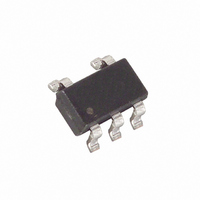MAX4040EUK+T Maxim Integrated Products, MAX4040EUK+T Datasheet - Page 9

MAX4040EUK+T
Manufacturer Part Number
MAX4040EUK+T
Description
IC OP AMP R-R SNGL SOT23-5
Manufacturer
Maxim Integrated Products
Datasheet
1.MAX4040EUKT.pdf
(16 pages)
Specifications of MAX4040EUK+T
Amplifier Type
General Purpose
Number Of Circuits
1
Output Type
Rail-to-Rail
Slew Rate
0.04 V/µs
Gain Bandwidth Product
90kHz
Current - Input Bias
2nA
Voltage - Input Offset
250µV
Current - Supply
14µA
Current - Output / Channel
2.5mA
Voltage - Supply, Single/dual (±)
2.4 V ~ 5.5 V, ±1.2 V ~ 2.75 V
Operating Temperature
-40°C ~ 85°C
Mounting Type
Surface Mount
Package / Case
SOT-23-5, SC-74A, SOT-25
Number Of Channels
1
Voltage Gain Db
94 dB
Common Mode Rejection Ratio (min)
65 dB
Input Offset Voltage
2.5 mV
Operating Supply Voltage
3 V, 5 V
Supply Current
0.02 mA
Maximum Power Dissipation
571 mW
Maximum Operating Temperature
+ 85 C
Mounting Style
SMD/SMT
Maximum Dual Supply Voltage
+/- 2.75 V
Minimum Operating Temperature
- 40 C
Lead Free Status / RoHS Status
Lead free / RoHS Compliant
-3db Bandwidth
-
Lead Free Status / Rohs Status
Details
Other names
MAX4040EUK+T
MAX4040EUK+TTR
MAX4040EUK+TTR
Figure 1a. Minimizing Offset Error Due to Input Bias Current
(Noninverting)
Figure 1b. Minimizing Offset Error Due to Input Bias Current
(Inverting)
Figure 2. Input Protection Circuit
R3 = R1
R3 = R1
V
V
IN
IN
R2
R2
IN+
IN-
R3
R1
R3
R1
_______________________________________________________________________________________
Micropower, Rail-to-Rail I/O Op Amps
Single/Dual/Quad, Low-Cost, SOT23,
2.2k
2.2k
R2
R2
MAX4040–
MAX4044
MAX4040–
MAX4044
The MAX4040–MAX4044 family’s inputs are protected
from large differential input voltages by internal 2.2k
series resistors and back-to-back triple-diode stacks
across the inputs (Figure 2). For differential input volt-
ages (much less than 1.8V), input resistance is typically
45M . For differential input voltages greater than 1.8V,
input resistance is around 4.4k , and the input bias
current can be approximated by the following equation:
In the region where the differential input voltage
approaches 1.8V, the input resistance decreases expo-
nentially from 45M
conducting. Conversely, the bias current increases with
the same curve.
The MAX4040–MAX4044 output stage can drive up to a
25k
Figure 3 shows the output voltage swing of a MAX4040
configured as a unity-gain buffer, powered from a single
+4.0V supply voltage. The output for this setup typically
swings from (V
load.
The MAX4040–MAX4044 operate from a single +2.4V to
+5.5V supply (or dual ±1.2V to ±2.75V supplies) and
consume only 10µA of supply current per amplifier. A
high power-supply rejection ratio of 85dB allows the
amplifiers to be powered directly off a decaying battery
voltage, simplifying design and extending battery life.
The MAX4040–MAX4044 typically require 200µs to
power up after V
the output is indeterminant. The application circuit
should allow for this initial delay.
load and still swing to within 60mV of the rails.
I
EE
BIAS
Applications Information
CC
+ 10mV) to (V
Power-Supply Considerations
= (V
to 4.4k
is stable. During this start-up time,
DIFF
Rail-to-Rail Output Stage
Power-Up Settling Time
- 1.8V) / 4.4k
as the diode block begins
CC
- 10mV) with a 100k
9












